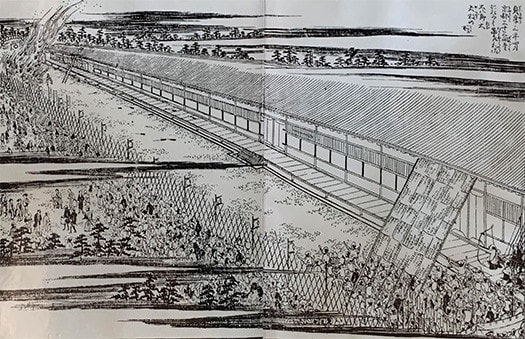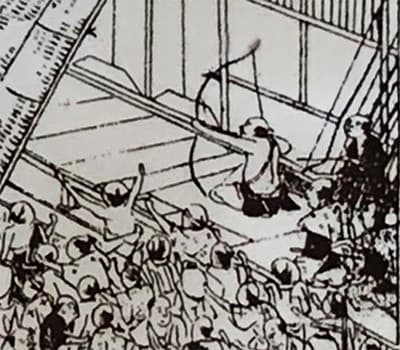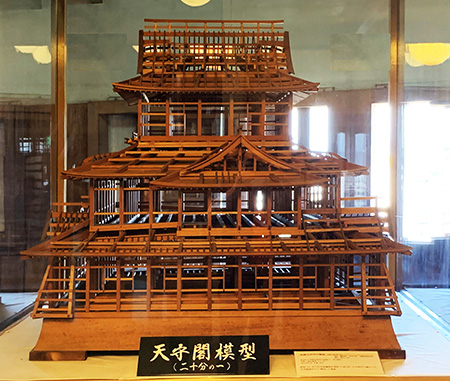



和歌山城の創建期から探究していていろいろな「掘り起こし」がある。
歴史というのは実にいろいろな人間模様を教えてくれる。
三十三間堂というのは京都の有名建築で、縁の長さが三十三間あるとされる。
京都市東山区三十三間堂廻町にある天台宗寺院。建物正式名は蓮華王院本堂。
京都市東山妙法院が所有・管理。元は後白河上皇が自身の離宮内に創建した仏堂。
桁行118.2メートル33間、梁間3間の建築本体四方に1間幅の庇を設けた形。
この長大な縁の空間を目にして、通し矢というイベントを思いつくのは
創建が平清盛であり武家の時代が始まったことと無関係ではないと思われる。
本堂西側の軒下を南から北に矢を射通す弓術競技。安土桃山時代に行われ始め、
江戸時代前期に各藩の弓術家により盛んに行われ、京の名物行事となった。
縁の北端に的を置き、縁の南端から軒天井に当たらぬよう矢を射抜き本数を競った。
藩の後押しで多くの弓術家が技量を競ったことから名誉となり、
一昼夜での通し矢数を競う「大矢数」の記録達成者は「天下一」を称した。
1686年4月27日に紀州藩の和佐範遠(大八郎)が総矢数13,053本中通し矢
8,133本で天下一となり、これが現在までの最高記録を達成した。
この紀州藩士が挑戦したのにはエピソードがあり
戦時下に長谷川一夫主演で日本映画会社すべての協力体制の元、撮影された。
史実に基づいた映画。和佐範遠は過去の新記録保持者の子どもであり、
その記録を尾張藩の家臣・星野勘佐衛門に破られたことから恥じて
父親は自害して果てたという因縁があった。
そういうことからいわば父の仇討ちのような背景事情があったのだ。
で、映画では尾張藩側の妨害工作、浪人を雇っての襲撃まで活写される。
映画らしく、その襲撃から和佐範遠を守ったのが星野勘佐衛門その人という
意外な展開を見せて物語として盛り上げている。
そして見事、三十三間堂通し矢の新記録を樹立することに成功する。
この新記録樹立に対しては京都で盛大な祝宴が催され、
紀州徳川家2代藩主・徳川光貞が直々でかれを出迎え300石の褒美を与えた。

2重の意味でなんとも興味深い歴史事実。
江戸の泰平の世での武士の「生き様」というものが切なく伝わってくるのと、
戦時下で「武士道精神発揚」の意味合いで軍部の許可を得て
ようやく映画制作にこぎ着けた「銃後の人々」の思い。
日本人と武士道というものが一種、象徴的なものとして伝わってくる。
いまちょうど、NHK大河ドラマでは「鎌倉殿と13人」が
始原期のドロドロの武家政治について取り上げているけれど、
その後の武士道の姿について、この三十三間堂通し矢はいろいろな
語り口で教えてくれるものがある。
現代でも似たようなメンタル支配下にあるロシアの蛮行はまことに白日の狂気。
われわれ現代日本は冷静に防衛力を高めなければ
むなしい武士道に生きざるを得なかった先人たちにも申し訳がないと思う。
English version⬇
Sanjusangendo "Passing arrow" Bushido with a false name - Exploring Nara and Wakayama - 30
The honor of being praised and the priority of form. Hana no taijutsu katsudo kyoka event. Bushido, a way of life at the mercy of empty values. ...
I have been exploring Wakayama Castle since its foundation and have "dug up" a lot of things.
History teaches us a lot about the human condition.
Sanjusangendo is a famous building in Kyoto with a 33-meter-long rim.
It is a Tendai sect temple located in Sanjusangendo Mawaricho, Higashiyama-ku, Kyoto. The building's official name is Rengeoin Main Hall.
Owned and managed by Higashiyama Myoho-in, Kyoto. Originally a Buddhist temple built by Emperor Go-Shirakawa in his own detached palace.
The main body of the building is 118.2 meters long with 33 ken and 3 beam spans, and has 1 ken wide eaves on all four sides.
This long rimmed space is the only one that brings to mind the event of the "through-arrow" ceremony.
It is not unrelated to the fact that the building was built by Taira no Kiyomori, the founder of the warrior class.
This is an archery event in which arrows are shot through the eaves of the west side of the main hall from south to north. It began to be practiced in the Azuchi-Momoyama period (1573-1600).
In the early Edo period (1603-1867), it was actively practiced by archers of various clans and became a famous event in Kyoto.
The target was placed at the north end of the rim, and arrows were shot from the south end of the rim to avoid hitting the eaves of the ceiling.
The event became an honor because many archers competed with their skills under the auspices of the clan.
The record holder of the "number of arrows shot in a single day and night" was called "the best in the world.
On April 27, 1686, Noriton Wasa (Daihachiro) of the Kishu Domain achieved a record of 8,133 arrows out of a total of 13,053 arrows.
This was the highest record to date.
There is an episode behind this Kishu clan member's challenge.
It was filmed during wartime with the cooperation of all Japanese movie companies, starring Kazuo Hasegawa.
The film is based on historical fact. Noriton Wasa was the child of a past new record holder, and
He was ashamed when his record was broken by Kanzaemon Hoshino, a vassal of the Owari Clan.
The record was broken by Hoshino Kansaemon, a vassal of the Owari clan, and his father was so ashamed that he committed suicide.
This is why there was a background circumstance that was akin to avenging his father's death.
In the movie, the sabotage by the Owari clan side and the attack by hiring ronin (ronin) are vividly depicted.
The film shows an unexpected development in the story, and the story is that it was Hoshino Kansaemon himself who protected Wasa Noriton from the attack.
The story is enlivened by the unexpected development that it was Hoshino Kansaemon himself who protected Wasa Noritoshi from the attack.
The film successfully sets a new record for the Sanjusangendo through-arrow attack.
A grand banquet was held in Kyoto to celebrate the new record.
The second lord of the Kishu Tokugawa family, Mitsusada Tokugawa, personally welcomed him and rewarded him with 300 koku.
This is an interesting historical fact in a double sense.
One, it gives us a poignant picture of the "way of life" of the samurai in the peaceful days of Edo, and two, it shows us the "spirit of bushido" in wartime.
The film was made under wartime conditions with the permission of the military to "promote the spirit of bushido".
The feelings of the "people after the guns" who finally managed to make the film after receiving permission from the military to "promote the spirit of bushido" during the war.
The Japanese people and bushido are conveyed as a kind of symbol.
The NHK historical drama "Kamakura-dono and the Thirteen" is being broadcast right now.
The drama is about the doldrums of samurai politics during the Hajime period, but it is also about the subsequent form of bushido.
The Sanjusangendo Passage tells us about the form of Bushido after that time in various ways.
The Sanjusangendo Passage has a lot to teach us about the later form of bushido through its various narratives.
The barbarism of Russia, which is under similar mental control even today, is truly a madness in the light of day.
We, modern Japan, must calmly raise our defenses.
I feel sorry for our predecessors who were forced to live a vain Bushido life.



















